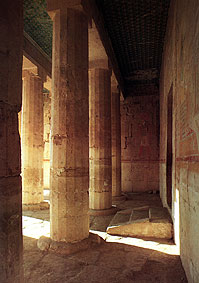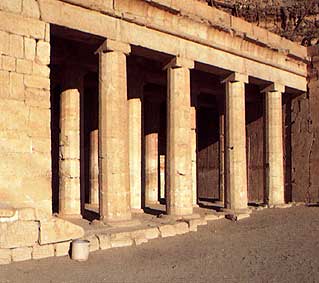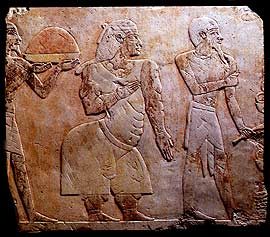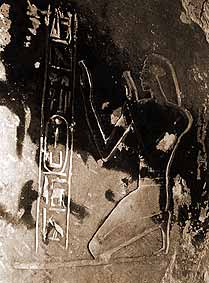|
Lower
Court
Although the majority
of the scenes here have been destroyed, some do still survive
- most notiably a scene of Tuthmosis III dancing before the god
Min, and also a scene showing the journey of two obelisks down
the Nile (see were erected at the temple of Karnak).
Middle
Court
Anubis
Chapel
Any scenes of Hatshepsut
have been destroyed, but scenes showing Tuthmosis III still survive
(he is shown worshipping Seker). The chapel also has figures
of many gods - Anubis, Nekheb, Uaset, Amen-Ra, Harmachis, Osiris
(but Anubis occurs the most - in one scene Hatshepsut (now erased)
makes offerings to him).
Anubis
Chapel
Birth
Colonnade
These
scenes are a repetition of scenes carved on the walls of the
temple at Karnak and show Hatshepsut's divine birth (these scenes
are now much damaged, mostly due to a vengeful Tuthmosis III,
but also to Akhenaten who had the images of Amun-Re erased as
part of his religious crusade).
The scenes
start with Amen-Ra and an astral version of the unborn Hatshepsut,
the gods decide that Queen Ahmose (wife of Tuthmosis I) would
be a perfect mother for this unborn child. Once this has been
decided Amun-Re comes down to Earth and enters Ahmose's chamber
after assuming the form of Tuthmosis I (Amun-Re at first finds
Ahmose asleep but his godly presence wakes her), using his divine
breath he impregnates Ahmose. Before he leaves, Amun-Re reveals
his true nature to Ahmose and then that she will give birth to
a daughter who will live to rule Egypt. Amun-Re then visits the
god Khnum and tells him to fashion a human body for the unborn
Hatshepsut:
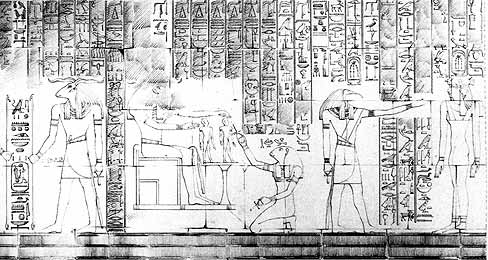
Queen
Ahmose is now heavily pregnant, she is led to the birthing room
by the gods Heket and Khnum:
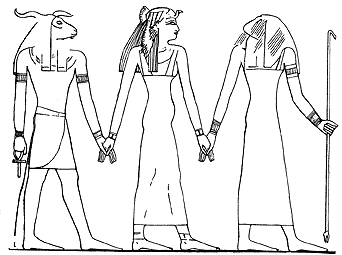
The Queen
is then shown with midwives at the time of the birth, various
gods also attend the birth (including Meskhent the goddess of
births), after the birth two Hathor goddesses suckle the baby
and its astral self. Finally the goddess of history, Safkhet,
makes a record of Hatshepsut's birth.
Punt
Colonnade
These
scenes show the famous expedition to Punt during Hatshepsut's
reign. The story begins with the Egyptian expedition (in two
boats) arriving at the mysterious land of Punt, the sailors are
rowing as the boats reach their destination:

"Arriving
at the goodly way into God's Land, journeying in peace to the
land of Punt".
Once
the Egyptians land, a force of soldiers carrying spears, axes
and shields are made ready in case of attack.The Egyptians have
also brought with them some items to trade (strings of beads,
an axe, a dagger, some bracelets and a wooden chest. The people
of Punt welcome the Egyptians warmly, the Chief of Punt - Parahu
- steps forward to meet the Egyptian officer (Parahu's wife is
shown behind him, many different explanantions have been offered
to explain her strange appearance ranging from suffering from
a disease to being overweight), two sons and a servant drive
along a donkey which the queen, Parahu's wife, sometimes rides:
The men
of Punt then address the Egyptians:
"Why
have you come into this land, which the people of Egypt do not
know? Did you come down the ways of heaven, or did you sail upon
the sea and upon the water's of God's land? Or have you trodden
the path of the sun? As for the King of Egypt, is there no way
unto his majesty that we may live by the breath which he gives?"
The village
in which the people of Punt live is also shown:

The houses
appear to have been built on stilts as the water seems to come
right up to the steps.
The people
of Punt then present the Egyptians with incense, gold rings and
other valuable items - the Egyptians then give a feast in honour
of thanks to the Chieftain of Punt.
The Egyptian
soldiers are then shown carrying incense trees back to the ship
in baskets:
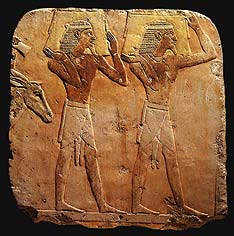
The ships
are shown, the baskets are being carried on board by the soldiers
- along with many other items ( including a baboon, and trees
in pots):

"The
loading of the ships very heavily with the marvels from the land
of Punt; all goodly fragrant woods, heaps of myrrh-resin, with
fresh myrrh trees, with ebony and pure ivory, with green gold
of Amu, with cinnamon-wood, khesyt-wood, with ahmut-incense,
senter-incense, eye cosmetic, with apes, monkeys, dogs, with
skins of the southern panther, and with natives and their children"
Other
scenes then show the boats on their triumphant return to Egypt,
thirty-one incense trees have been brought safely back along
with cattle, incense leaves, skins, chests of gold, panthers,
and other animals along with silver, lazuli, malachite and other
precious stones.
Hathor
Chapel
Several
of the columns in the chapel have been destroyed, although the
surviving columns show them to have Hathor capitals similar to
those found at Denderah:
 |
 In
a festival scene, soldiers run forward carrying branches of trees
along with their axes.
In
a festival scene, soldiers run forward carrying branches of trees
along with their axes.
|
Tuthmosis
III is shown presenting a sacred oar to Hathor, Hatshepsut dances
before Hathor, Hathor licks the hand of an enthroned pharaoh.
In the shrine of the Hathor Chapel, Hatshepsut is shown suckling
one of Hathor's udders, and at the end of the chapel Hatshepsut
is shown seated between Hathor and Amun-Re.
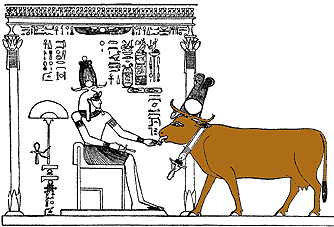
The Upper
Court
The name
of Hatshepsut in this upper level has in most places been replaced
by that of Tuthmosis III. The Upper Court consists of niches
in the wall, in the middle is a doorway which leads to the inner
sanctuary. The decoration inside consists of scenes of gods (Harmachis
(there is also a limestone altar to Harmachis - any other gods
near to this altar were destroyed by Akhenaten - Harmachis was
as a form of the Aten) , Amun-Re, Min), once more any figures
of Hatshepsut have been destroyed. There are also scenes of Tuthmosis
I and Queen Senseneb (Tuthmosis I's possible mother - if he was
a son of Amenhotep I) making offerings to Anubis.
Two
images which come from the Upper Court - Hatshepsut, and a figure
of Senenmut from one of the niches
The Sanctuary
In here
there are various scenes of offerings to Amun-Re; Hatshepsut
and her daughter Raneferu kneel before the barque of Amun-Re;
Hatshepsut, Tuthmosis III and the Princess Raneferu sacrifice
to the barque of Amen-Re. The most inner room of the Sanctuary
was re-built in Ptolemaic times and scenes honour the deified
Imhotep and Amenhotep son of Hap.
The Mortuary
Temple after Hatshepsut.
After
Hatshepsut's death, Tuthmosis III replaced her image with his
own - or erased her image completely as detailed above. Akhenaten
then attacked the image of Amun-Re during his religious 'crusade'
against the old gods, some additions to the temple were made
by Ramesses II, Merneptah inscribed his name on the walls, in
the Ptolemaic Period made some repairs to the temple (and mistook
the temple to be in honour of Imhotep and Amenhotep son of Hap).
Finally a Christian Monastery was built upon the ruins which
left little of original temple visible.
Many
burials are also to be found placed around the temple - in the
21st / 22nd Dynasty a cache of High Priests (163 mummies) was
buried a few yards to the north of the temple.
|









